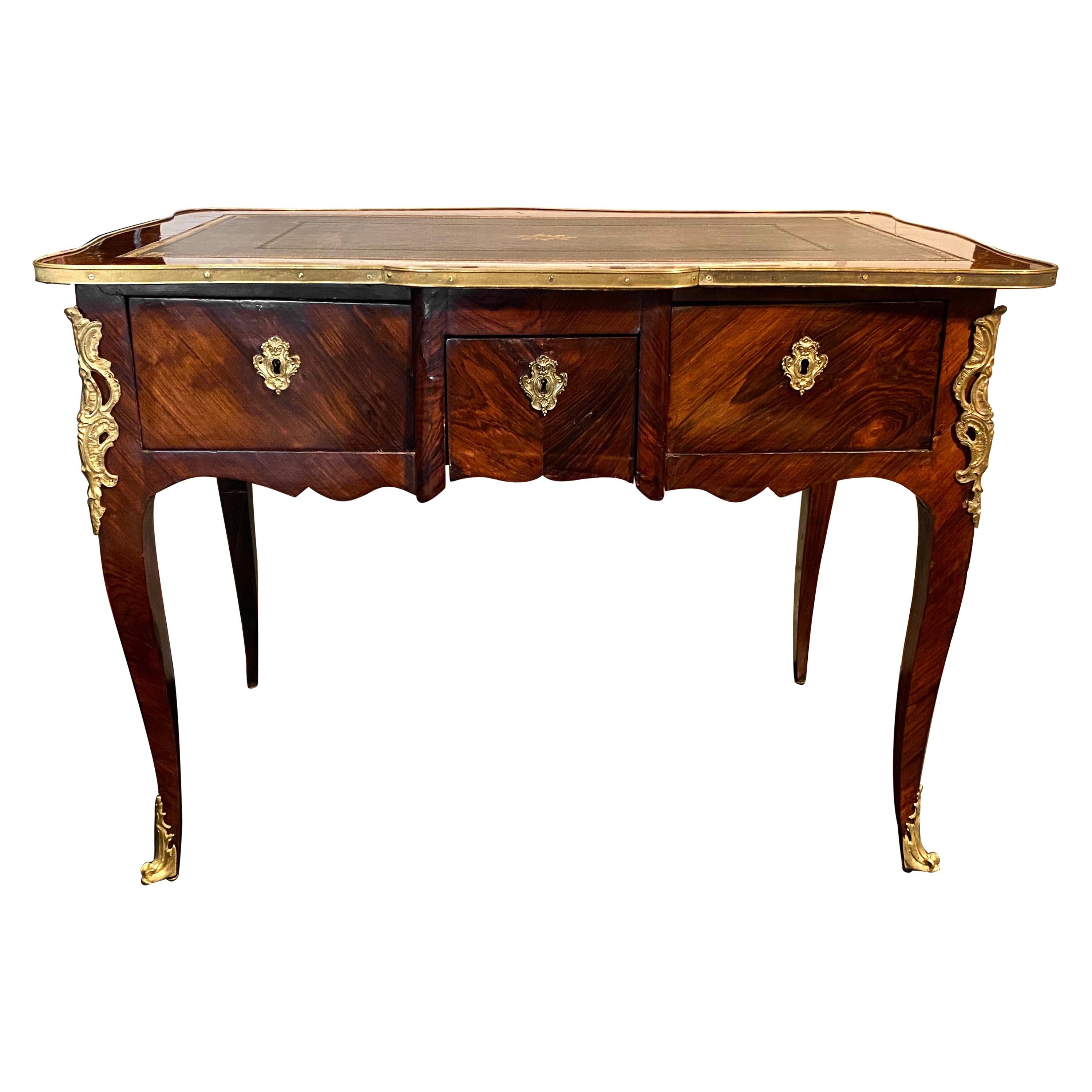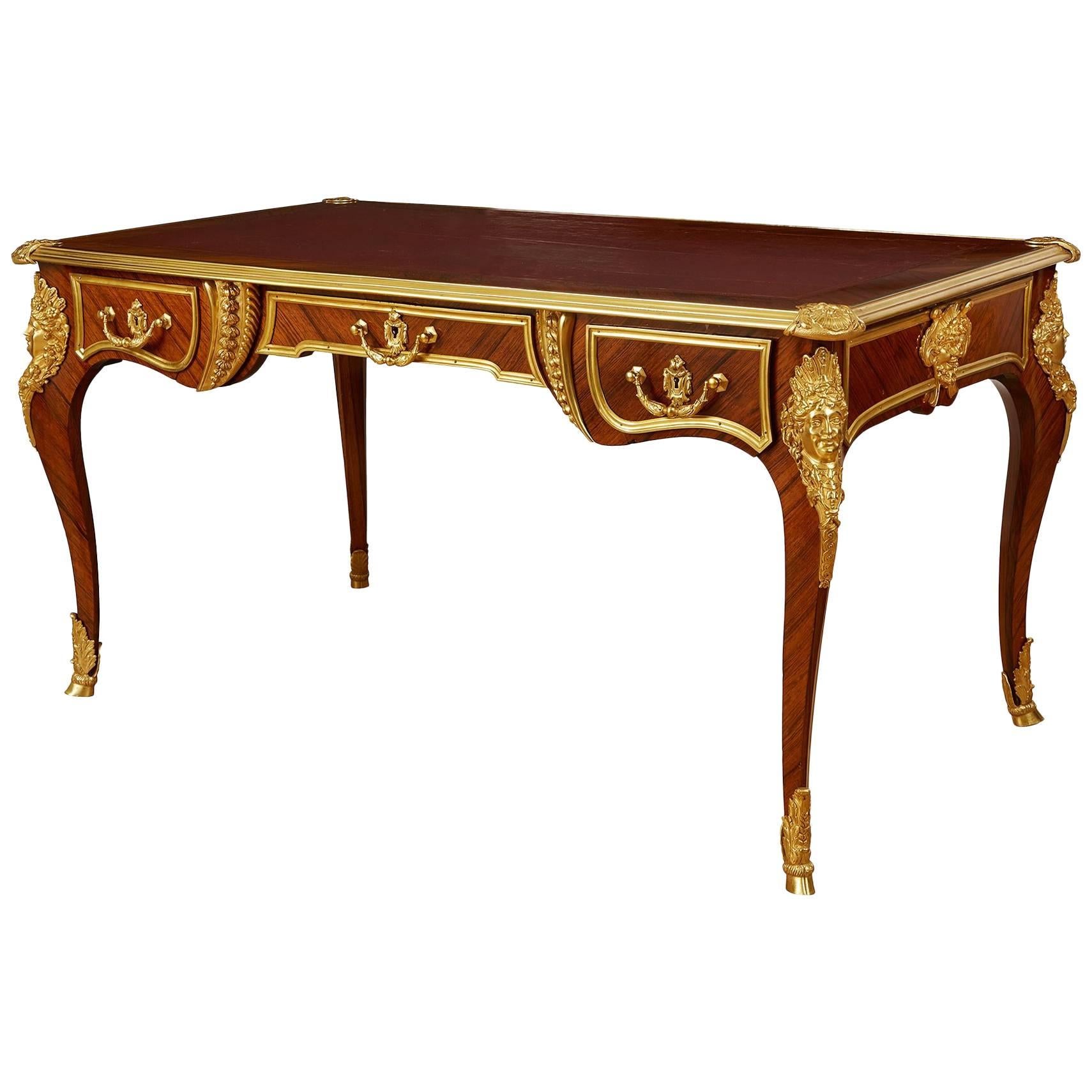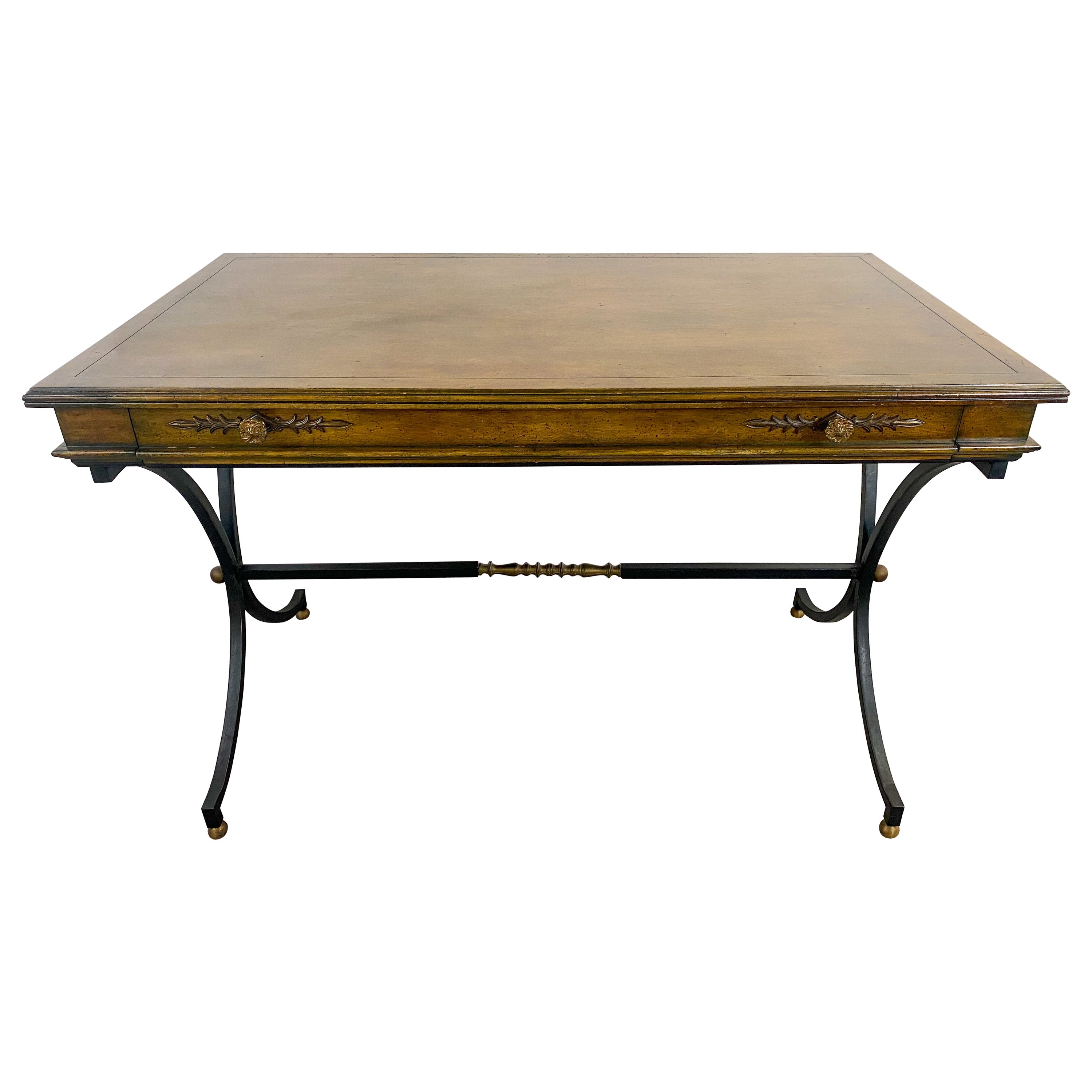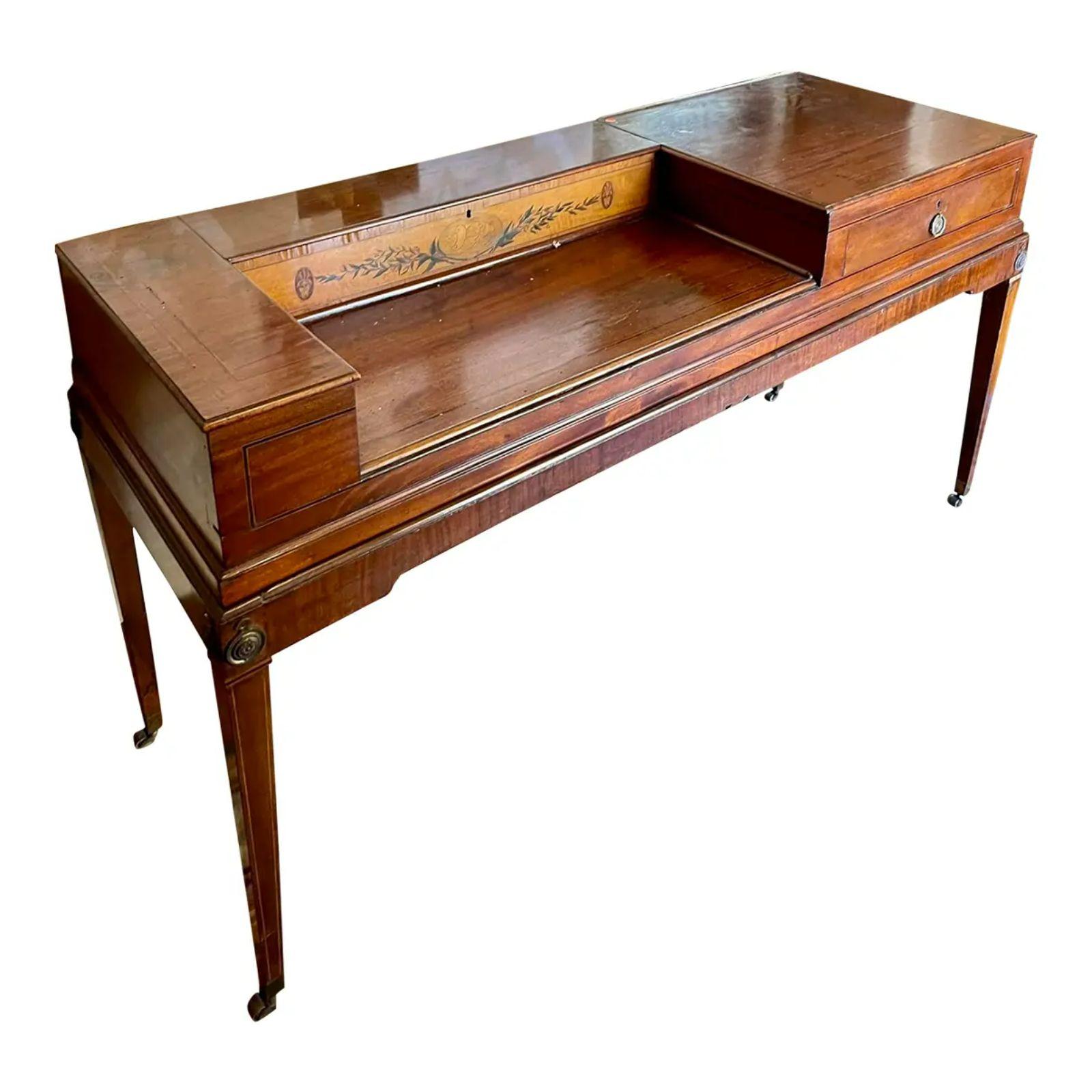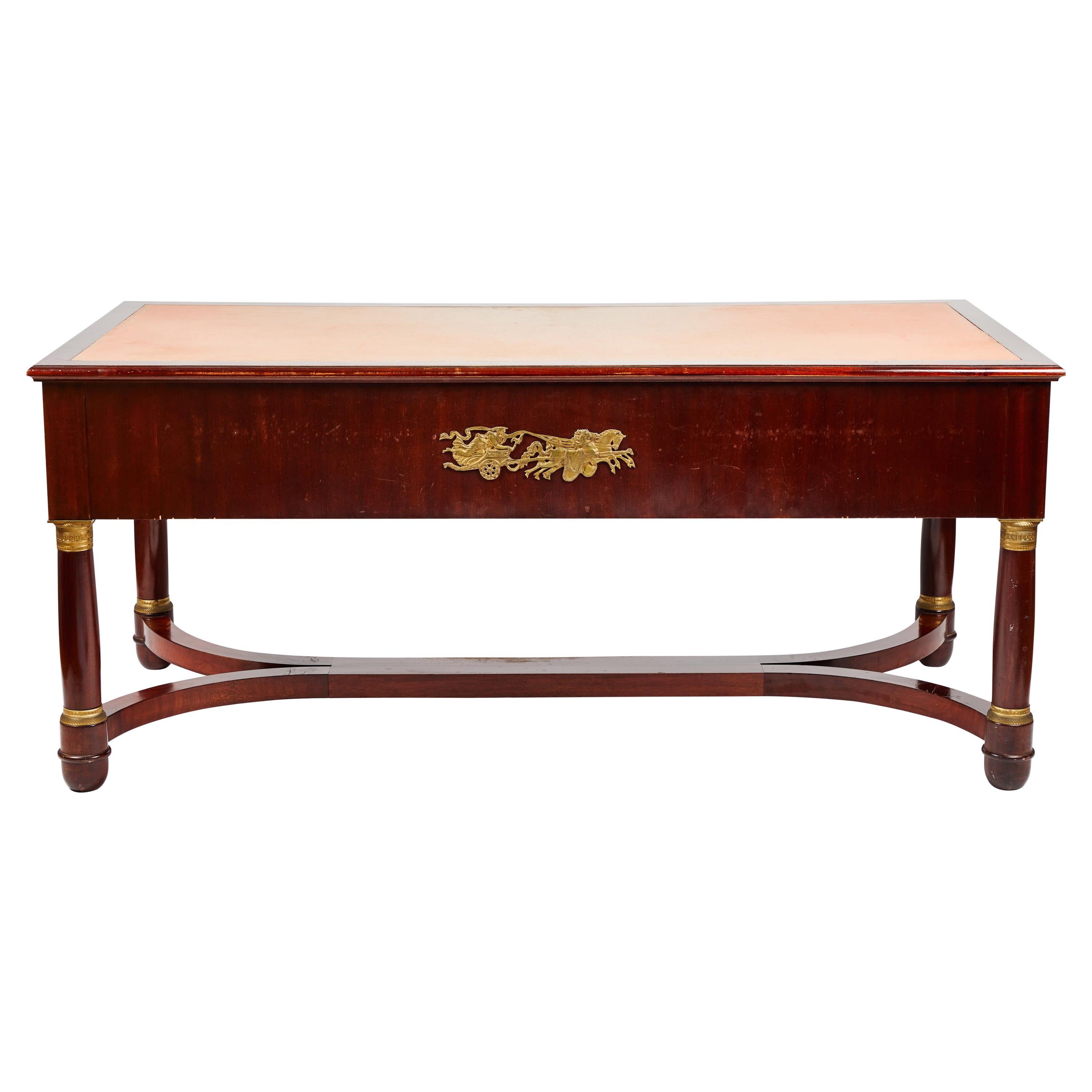Items Similar to Régence Style Marquetry Writing Desk
Want more images or videos?
Request additional images or videos from the seller
1 of 20
Régence Style Marquetry Writing Desk
About the Item
A magnificent and very rare Régence style marquetry inlaid grand bureau plat or writing desk.
Inscribed to the carcass 'Moreaux 72'.
Dating from the second half of the nineteenth century this magnificent and very rare bureau plat has finely cast rocaille gilt-bronze mounts and is decorated overall with truly breath-taking seventeenth century marquetry, depicting fantastical townscapes, knights, soldiers, hunting and architectural-scenes.
Of serpentine rectangular form the top is veneered with superb marquetry panels within a foliate scrolled border and a rocaille shell-cast gilt-bronze surround, both sides featuring a recessed central drawer flanked on each side by a drawer applied with male and female terms, scrolled handles, and reserves with conforming drawers; the bombé sides are centred by foliate scrolls, and the whole raised on cabriole legs headed by cartouches with foliate entwined chutes terminating in scrolled sabots.
Of impressive scale this fine bureau plat, in the manner of a partners desk, features working drawers to each side.
This model of bureau plat was made by a small number of celebrated Parisian cabinet makers in the second half of the 19th century including Beurdeley, Cremer and Befort Jeune. It is incredibly rare to see this model of bureau plat inlaid in marquetry.
The exceptional quality and style indicate the use of older reused marquetry, almost certainly dating from the late 17th century and originating from the Augsburg region of Germany.
Similar models but lacking the exceptional marquetry inlay can be found in the collection of the Duke of Buccleuch at Bowhill, and the Earl of Normanton at Somerlely. Christopher Payne notes that the latter was part of a pair sold by the London dealer Toms & Luscombe in 1871. He illustrates the present bureau plat in his book ‘European Furniture of the 19th Century’ (p. 88-89), along with two related desks minus the marquetry inlay (p. 92 -93).
The exceptional and highly complex marquetry inlay and intarsia work, that sets this important bureau plat apart from other extant examples, would originally have formed the decorative panels of a late 17th century table cabinet, almost certainly ascribable to the Augsburg region of Germany.
Augsburg emerged from the middle of the 16th century as the German centre of luxury cabinet making for the international market. In particular, the development of marquetry contributed to this prominent position, favoured by the ready availability of indigenous woods and the reputation that Augsburg had the best craftsmen able to cut thin layers of veneers in the most intricate motifs (C.S. Wood, ‘The Perspective Treatise in Ruins: Lorenz Stöer, Geometria et perspectiva, 1567’, Studies in the History of Art, no. 59, p. 246).
Table cabinets, conceived as a form of Wunderkammer or cabinets of curiosities, were intended as repositories for all manner of wondrous and exotic objects and by the 1550s the grandest cabinets in Europe were being made in Augsburg. Decorated almost entirely with sumptuous marquetry, often depicting perspective views of ruins and fantastical townscapes, they become by the 1590s highly regarded as important diplomatic gifts.
Fine Augsburg marquetry panels remained popular throughout the ages and were frequently re-used to create or embellish new items of furniture, such as this magnificent bureau plat. Their inclusion was not only for their highly decorative appeal, but to contemporary eyes, a means by which to imbue a new creation with a sense of true historical authenticity.
The importance of such panels is often reflected in the high cost involved in repurposing them. A fine example of this is the celebrated 17th century cabinet on stand in the collection of the V&A, enlarged and adapted by the London cabinetmakers Morant & Boyd around 1850 (V&A O187250). A further documented example is a chest of drawers probably made in Turin in the middle of the 18th century now at Waddesdon Manor (Geoffrey de Bellaigue, The James A. de Rothschild collection at Waddesdon Manor, Furniture, Clocks and Gilt Bronzes, Fribourg, 1974, no. 119).
With its confection of designs and motifs, the marquetry on this important desk reflects a Germanic abstract representation of pictorial form, referencing more the densely populated narratives of Albrecht Dürer, that the trompe l’oeil architectural vistas of the Italian Renaissance and its Euclidean perspective.
The epic themes of hunting, knightly exploits and courtly love are inspired by Middle High German literature (1050–1350) such as the Spielmannsdichtung and the Nibelungenlied, with their heroic tales and colourful characters.
In keeping with the marquetry and intarsia work of the period, the designs of fantastical townscapes, forests, ruins, knights, hunting, dogs, and curious wild animals would have been inspired by woodcuts and engravings such as: Lorenz Stöer’s ‘Geometria et perspectiva’ (Augsburg, 1567), Jost Amman (1531-1591), or the etchings of Virgil Solis as found in Buchlin von den alten Gebewen (c. 1555).
This highly influential book of 11 woodcuts Geometria et perspectiva by Lorenz Stöer, (Augusburg 1597) shows combinations of regular and semi-regular solids in landscapes with fanciful ornamental shapes. The book, which included no text, was subtitled:
'Herein are a few ruined buildings, useful to cabinetmakers working in inlaid wood, and for the special pleasure of many other amateurs, arranged and presented by Lorenz Stoer, painter and citizen of Augsburg'.
An interesting Augsburg cabinet in the collection of the V&A Museum, following the box-like form of a Spanish escritorio (writing desk) dates to 1565 and bears the initials of the anonymous master 'HS'. The marquetry decoration with its fantastical ruined townscape, although unpopulated, is reminiscent in style to the marquetry of the present bureau, especially in the filling of the skies with birds. This design derives from the popular engravings of the planets by Vergil Solis of Nuremberg (1514-1562) and of Roman ruins by Hieronymus Cock of Antwerp (about 1510-1570). Such designs were never slavishly copied and often disparate elements from several engravings would be incorporated.
In the decoration to this important bureau plat, we can see a distinct layering of perspective and pattern, the intarsia disposing figures and elements within a two-dimensional plane to create an intriguing atmospheric world of myth and legend, of depth emerging out of flatness.
Literature
Christopher, Payne, European Furniture of the 19th Century, Antique Collectors Club, 2013; pp. 88-89 & 92-93.
Christopher S. Wood. The Perspective Treatise in Ruins: Lorenz Stoer, Geometria et perspectiva, 1567.
- Dimensions:Height: 37.41 in (95 cm)Width: 87.8 in (223 cm)Depth: 43.31 in (110 cm)
- Style:Louis XV (In the Style Of)
- Materials and Techniques:Ormolu,Wood,Marquetry
- Place of Origin:France
- Period:Mid-19th Century
- Date of Manufacture:circa 1850
- Condition:Wear consistent with age and use.
- Seller Location:Brighton, GB
- Reference Number:
About the Seller
5.0
Recognized Seller
These prestigious sellers are industry leaders and represent the highest echelon for item quality and design.
Established in 1964
1stDibs seller since 2014
48 sales on 1stDibs
Typical response time: 1 hour
Associations
The British Antique Dealers' AssociationLAPADA - The Association of Arts & Antiques Dealers
- ShippingRetrieving quote...Ships From: Brighton, United Kingdom
- Return PolicyA return for this item may be initiated within 7 days of delivery.
More From This SellerView All
- Rare Gilt-Bronze Mounted Marquetry Pedestal Desk by François Linke, circa 1900By François LinkeLocated in Brighton, West SussexA rare gilt bronze mounted marquetry pedestal desk by François Linke. French, circa 1900. Linke Index Number 711. Linke title ‘Bureau LXV à 8 pieds’. Stamped to the insi...Category
Antique Late 19th Century French Louis XV Desks and Writing Tables
MaterialsBronze
- Louis XVI Style Marquetry Writing Table after Jean-Henri Riesener, circa 1870By Jean-Henri RiesenerLocated in Brighton, West SussexA Louis XVI style gilt bronze mounted mahogany and Marquetry inlaid writing table after the model by Jean-Henri Riesener. This finely inlaid writing ...Category
Antique Mid-19th Century French Louis XVI Desks and Writing Tables
MaterialsBronze
- Regence Style Gilt-Bronze Mounted Parquetry Bureau PlatBy Charles CressentLocated in Brighton, West SussexA fine Regence style gilt-bronze mounted parquetry bureau plat, in the manner of Charles Cressent. This fine parquetry inlaid bureau plat has a too...Category
Antique 19th Century French Desks and Writing Tables
MaterialsOrmolu
- Regence Style Ebonised Bureau Plat by Sormani, circa 1880By Paul SormaniLocated in Brighton, West SussexA fine Regence style ebonised and gilt-bronze mounted bureau plat by Sormani. Paris, circa 1880. The central drawer bearing a label for ‘VVE P. SORMANI & FILS 10, r. Charlot Pa...Category
Antique Late 19th Century French Régence Desks and Writing Tables
MaterialsBronze
- Louis XV Style Parquetry Inlaid Writing-Table by François Linke, circa 1890By François LinkeLocated in Brighton, West SussexA Louis XV Style gilt bronze-mounted parquetry inlaid writing-table, by François Linke. French, circa 1890. Stamped 'FL' to the reverse of the centre bronze mounts to the front...Category
Antique Late 19th Century French Louis XV Desks and Writing Tables
MaterialsBronze
- Rare Louis XV Style Marquetry Inlaid Bureau de Dame François Linke, circa 1980By François LinkeLocated in Brighton, West SussexA rare and unusual Louis XV style gilt-bronze mounted and marquetry inlaid Bureau de Dame by François Linke. French, circa 1890. Signed to the gilt-bronze rim ‘Linke’. Stampe...Category
Antique Late 19th Century French Louis XV Desks and Writing Tables
MaterialsBronze
You May Also Like
- Louis XV Style Bureau Plat Writing Desk, Rosewood and OrmuluLocated in Montreal, QuebecAntique Louis XV style bureau plat writing desk, rosewood and Ormulu mounts, raised on cabriole legs. Tooled leather top. Dimensions: 43” W x 31.5” H x 25.5” D Side drawers (2): ...Category
Antique Late 19th Century French Louis XV Desks and Writing Tables
MaterialsBronze
- French Louis XV Style Gilt Bronze-Mounted Kingwood Writing DeskLocated in London, GBThis beautiful desk, beautifully finished in kingwood, leather and gilt bronze, is a fantastic piece of 19th century French design in the Louis XV style. Elegant, beautifully crafted...Category
Antique 19th Century French Louis XV Desks and Writing Tables
MaterialsBronze, Ormolu
- French Hollywood Regency Style Mahogany Writing DeskLocated in Plainview, NYA classy mid-20th century French Hollywood Regency style writing desk. The desk is made of solid mahogany and has one large drawer standing...Category
Mid-20th Century Hollywood Regency Desks and Writing Tables
MaterialsBrass, Iron
- Antique French Ormolu Mounted Escritoire Writing DeskLocated in London, GBA stunning antique French writing table, also known as an escritoire. This dates from around the 1930’s. It is has a very beautiful and useful design, with a very elegant form. Ther...Category
Vintage 1930s French Louis XV Desks and Writing Tables
MaterialsOrmolu
- Antique Mahogany Adams Style Regency Writing Table Desk, 19 CenturyLocated in LOS ANGELES, CAAntique 19th century Mahogany Adams Style Regency writing table desk. Additional information: Materials: Mahogany Please note that thi...Category
Antique 19th Century Regency Desks and Writing Tables
MaterialsMahogany
- French Empire Mahogany Writing DeskLocated in LOS ANGELES, CAMahogany construction with rectangular leather writing surface with gilt brass medallion pulls. Back has gilt metal chariot and horse plaque. Top sits on ...Category
Antique Late 19th Century French Empire Desks and Writing Tables
MaterialsBrass
Recently Viewed
View AllMore Ways To Browse
Panelled Desk
Important Desk
Bronze Writing Desk
Two Sided Writing Table
Patterned Desk
Solid Wood Desk Used
Antique Two Sided Desk
Two Sided Desk Antique
Used Solid Wood Desks
Small French Desk
L Desk
Rare Antique Desk
Small Antique Writing Desk
Small Writing Desk Antique
Antique Small Antique Writing Desk
Antique Small Writing Desk
Antique Writing Desk Small
Small Antique Writing Desks
